The Hindu Newspaper Analysis for UPSC
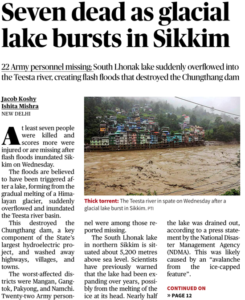
The Hindu Newspaper Analysis 4 October 2023
- At least seven people were killed and scores more were injured or are missing after flash floods inundated Sikkim on Wednesday.
- The floods are believed to have been triggered after a lake, forming from the gradual melting of a Himalayan glacier, suddenly overflowed and inundated the Teesta river basin.
- This destroyed the Chungthang dam, a key component of the State’s largest hydroelectric project, and washed away highways, villages, and towns.
- The South Lhonak lake in northern Sikkim is situated about 5,200 metres above sea level. Scientists have previously warned that the lake had been expanding over years, possibly from the melting of the ice at its head. Nearly half the lake was drained out, according to a press statement by the National Disaster Management Agency (NDMA). This was likely caused by an “avalanche from the ice-capped feature”.

- “It is observed that the lake is burst and about 105 hectares (about one square km) area (of the lake) has been drained out which might have created a flash flood downstream,” the ISRO said in a statement, releasing satellite images of September 28 and October 4 for comparison.
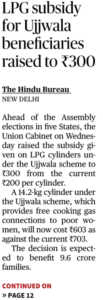
- The Ministry of Petroleum and Natural Gas (MOPNG), introduced the ‘Pradhan Mantri Ujjwala Yojana’ (PMUY) as a flagship scheme with the objective of making clean cooking fuel such as LPG available to the rural and deprived households which were otherwise using traditional cooking fuels such as firewood, coal, cow-dung cakes etc.
- Usage of traditional cooking fuels had detrimental impacts on the health of rural women as well as on the environment.
- Benefits of PMUY:
- The eligible beneficiaries receive a free LPG connection.
- The beneficiaries also receive a subsidy on the first six refills of 14.2 kg cylinders or eight refills of 5 kg cylinders.
- The beneficiaries can also join the PAHAL scheme to receive the subsidy amount directly in their bank accounts.
- A 14.2-kg cylinder under the Ujjwala scheme, which provides free cooking gas connections to poor women, will now cost ₹603 as against the current ₹703.
- The decision is expected to benefit 9.6 crore families.

- The 2023 Nobel Prize in Chemistry has been awarded to Alexei Ekimov, Louis Brus, and Moungi Bawendi for their work on quantum dots — very small crystals with peculiar properties that have found application in a variety of fields, from new-age LED screens to quantum computers.
- “Quantum dots are … bringing the greatest benefit to humankind, and we have just begun to explore their potential,” the Royal Swedish Academy of Sciences said in a statement on Wednesday. “Researchers believe that in future, quantum dots can contribute to flexible electronics, miniscule sensors, slimmer solar cells, and perhaps encrypted quantum communication.”
- Quantum dots are like jails for electrons. Imagine a tiny “box” in which you can trap electrons. Once you do this you can harness the quantum effects that electrons exhibit.
- Example: Electrons can absorb energy and emit light of a certain colour, depending on the size of the quantum dot.
- Quantum dots are particles that are nanosized in all three dimensions. They behave like artificial atoms, as they can have a fixed number of electrons in a confined space, leading to unique properties that are size-dependent. One of the key areas of interest is their interaction with light, which has led to the development of the field of nanophotonics.

- According to the laws of quantum mechanics, the observable properties of electrons in matter — like a fruit or a rock — change in a few hundred attoseconds. One attosecond is 10-18 seconds.
- To study these extremely rapid changes, special tools are needed, and Anne L’Huillier, Pierre Agostini, and Ferenc Krausz have received the 2023 physics Nobel Prize for building these tools.
- The medicine Nobel Prize this year celebrated the invention of mRNA vaccines and their effect on the COVID-19 pandemic. The utility for people here was straightforward, whereas that for attosecond physics is not.

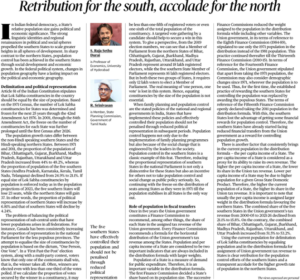
- In Indian federal democracy, a State’s relative population size gains political and economic significance.
- In sharp contrast to the northern States, population control has been achieved in the southern States through social development and economic growth.
- Article 81 of the Indian Constitution stipulates that Lok Sabha constituencies in the country should be equal by the size of population. Based on the 1971 Census, the number of Lok Sabha constituencies for States was determined and frozen for the next 25 years through the 42nd Amendment Act 1976.
- In 2001, through the 84th Amendment Act, the freeze on the number of constituencies for each State was further prolonged until the first Census after 2026.
- If equal size of Lok Sabha constituencies by population is enforced today as in the population projections of 2023, the five southern States will lose 23 seats, while the northern States will gain 37.
- Every Finance Commission recommends a formula for the horizontal distribution of the Union government’s tax revenue among the States. Population and per capita income of a State are considered to be two important indicators that are always included in the distribution formula with larger weights.
- Using the current population for delimitation of Lok Sabha constituencies by equalising population and in the distribution formula for assignment of Union government tax revenue to States is clear retribution for the population control efforts of the southern States and a transparent accolade for the higher growth rate of population in the northern States.
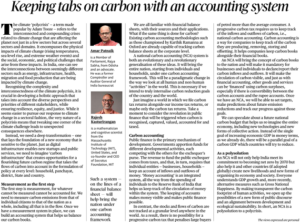
- The climate ‘polycrisis’ — a term made popular by Adam Tooze — refers to the interconnected and compounding crises related to climate change that are affecting the planet not just in a few sectors but across several sectors and domains.
- It encompasses the physical impacts of climate change (rising temperatures, sea-level rise, and extreme weather events) and the social, economic, and political challenges that arise from these impacts.
- In India, one can see the interconnections between seemingly different sectors such as energy, infrastructure, health, migration and food production that are being impacted by climate change.
- We need to measure carbon emissions from that of individual citizens to that of the nation as a whole, including all that is in the flow.
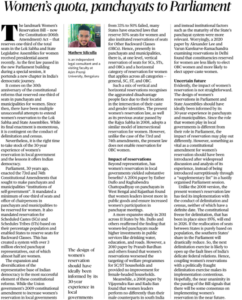
- The landmark Women’s Reservation Bill — now the Constitution (106th Amendment) Act — that reserves one-third of the total seats in the Lok Sabha and State Legislative Assemblies for women received presidential assent recently. As the first law passed in the new Parliament building during a special session, it portends a new chapter in India’s democratic journey.
- It comes on the 30th anniversary of the constitutional reforms that reserved one-third of seats in panchayats and municipalities for women.
- Parliament, 30 years ago, enacted the 73rd and 74th Constitutional Amendments that sought to make panchayats and municipalities “institutions of self-government”. It mandated a minimum of one-third of seats and office of chairpersons in panchayats and municipalities to be reserved for women.
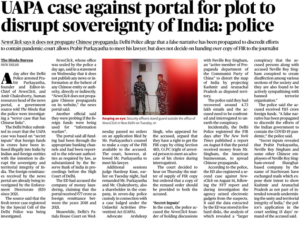
- A day after the Delhi Police arrested Prabir Purkayastha, founder and Editor-in-Chief of NewsClick, and Amit Chakraborty, human resources head of the news portal, a government source told The Hindu that the police were investigating a “terror case that has Chinese links”.
- The Delhi Police submitted in court that the UAPA case was based on “secret inputs” that foreign funds in crores have been infused illegally into India by Indian and foreign entities with the intention to disrupt the sovereignty and territorial integrity of India. The foreign remittances received by the news portal are already being investigated by the Enforcement Directorate (ED) since 2021.
- The police said the accused received ₹115 crore foreign funds. “A false narrative has been propagated to discredit the efforts of the Indian government to contain the COVID-19 pandemic,” the police said.
- The UAPA is aimed at prevention of unlawful activities association in India. Its main objective is dealing with activities directed against the integrity and sovereignty of India. It is also known as Anti-terror law.
- Unlawful activities refer to any action taken by an individual or association intended to disrupt the territorial integrity and territorial sovereignty in India.
- The act assigns absolute power to the central government and provides for death penalty and life imprisonment as the highest punishments.
- Major Provisions of the UAPA:
- UAPA provides special procedures to deal with terrorist activities, among other things; the central government may designate an individual/organization as a terrorist/terrorist organization if it:
- Commits/participates in acts of terrorism,
- Prepares for terrorism,
- Promotes terrorism, or
- Is otherwise involved in terrorism.
- Under the Act, an investigating officer is required to obtain the prior approval of the Director General of Police to seize properties that may be connected with terrorism.

- Defence Minister Rajnath Singh on Wednesday released the fifth Positive Indigenisation List of 98 items to be procured by the three Services from domestic sources in a staggered manner on specified timelines. He also released the Navy’s updated indigenisation road map, “Swavlamban 2.0”.
- The Department of Military Affairs compiled the list after several rounds of consultations with all stakeholders, the Defence Ministry said in a statement. “It lays special focus on import substitution of components of major systems, besides important platforms, weapon systems, sensors and munitions which are being developed and likely to translate into firm orders in the next five to 10 years,” it said.
- What is Positive Indigenisation List?
- The positive indigenisation list essentially lists items that the armed forces — Army, Navy, and Air Force — will procure only from domestic manufacturers.
- These manufacturers could be from the private sector or Defense Public Sector Undertakings (DPSUs).
- The Government has introduced a comprehensive revamped ‘Make and Innovation’ procedure to reduce dependency on arms and promote indigenous manufacturing of defence equipment.
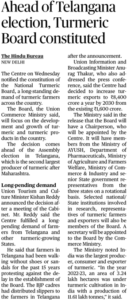
- The Centre on Wednesday notified the constitution of the National Turmeric Board, a long-standing demand of turmeric farmers across the country.
- The Board, the Union Commerce Ministry said, will focus on the development and growth of turmeric and turmeric products in the country.
- The decision comes ahead of the Assembly election in Telangana, which is the second largest producer of turmeric after Maharashtra.
- Turmeric cultivation in India:
- Turmeric can be grown in diverse tropical conditions from sea level to 1500 m above sea level, at a temperature range of 20-35 degrees Celcuis with an annual rainfall of 1500 mm or more, under rainfed or irrigated conditions.
- Though it can be grown on different types of soils, it thrives best in well-drained sandy or clay loam soils with a pH range of 4.5-7.5 with good organic status.

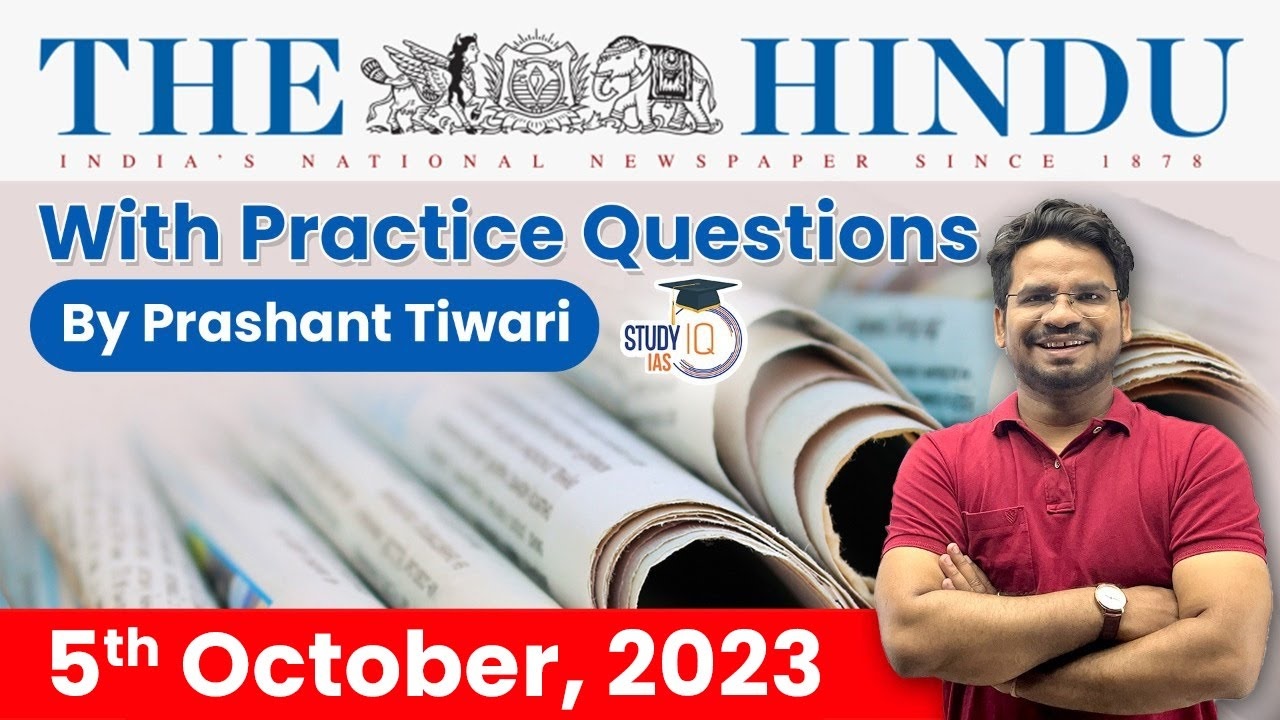
 The Hindu Newspaper Analysis 6 October 2...
The Hindu Newspaper Analysis 6 October 2...
 The Hindu Newspaper Analysis 4 October 2...
The Hindu Newspaper Analysis 4 October 2...
 The Hindu Newspaper Analysis 3 October 2...
The Hindu Newspaper Analysis 3 October 2...





















